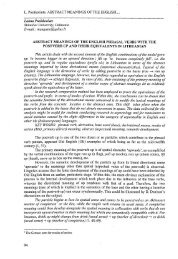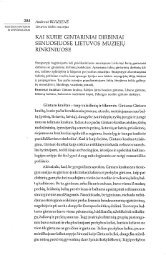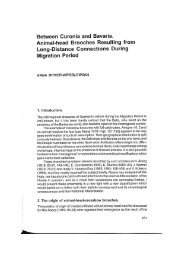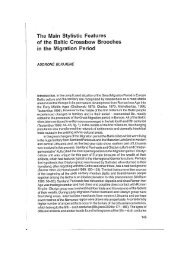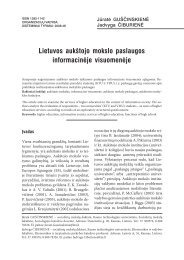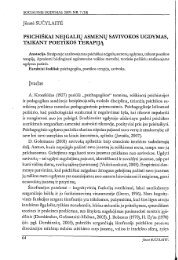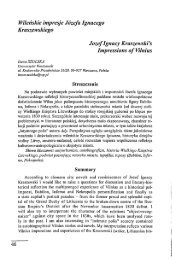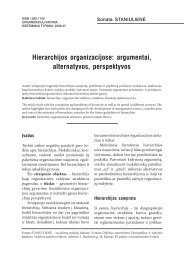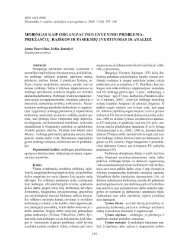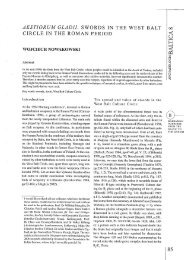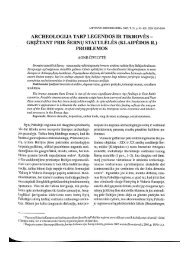ECO-MARKETING AND ECO-LABELLING: DOES IT ENSURE ...
ECO-MARKETING AND ECO-LABELLING: DOES IT ENSURE ...
ECO-MARKETING AND ECO-LABELLING: DOES IT ENSURE ...
Create successful ePaper yourself
Turn your PDF publications into a flip-book with our unique Google optimized e-Paper software.
D.Grundey 161 ISSN 1648-4460<br />
2.2 Design for the Environment<br />
Researching Cusiomer Loyally in Lithuania<br />
Coddington (1993) asserts that Design for tlie Environment (DFE) has emerged as a<br />
philosophy of integrating environmental considerations into the design process of both<br />
product and packaging. There are two basic tenets: (1) the firm engaged in DFE must<br />
internalize environmental considerafions and constraints, and (2) the firm must evaluate<br />
environmental issues systemically, in conjunction with associated manufacturing, economic,<br />
regulatory, social, and polifical factors (Allenby, 1991). Additional considerations inherent in<br />
DFE as applied to product and package design are designing for disposal, designing for<br />
nondisposal (recycling), designing for pollufion prevenfion, and designing for resource<br />
conservation. DFE strongly encourages the development of ideas that would incorporate<br />
waste reduction into producfion processes, recycling of products and/or packaging, that would<br />
make products compostable, or that would help facilitate changes in the process of design<br />
while adding more benefits than costs to the organization.<br />
2.3 Total Quality Management (TQM) for the Environment<br />
Friedman (1992) advocates that Total Quality Management (TQM), an increasingly<br />
popular concept related to the management of both the product and the producfion processes,<br />
needs to integrate environmental management issues. Commitment to quality now refers not<br />
only to the traditional production concept, but to environmental quality as well. Currenfiy, our<br />
concern is with the total yield of the producfion and product markefing processes, including<br />
waste and pollufion.<br />
Recycling. Regulatory pressures may account for some of the most creative ideas that<br />
have been brought to market. For example, batteries of all kinds contain hazardous heavy<br />
metals such as silver, mercury, nickel, cadmium and lead that can threaten underground water<br />
supplies. The potential for increased regulatory pressures always faces these manufacturers,<br />
including legal requirements to reformulate products or setting up collection programs for the<br />
"dead" product. In 1990, Eveready reformulated their batteries to reduce mercury content,<br />
meeting regulatory standards two years ahead of schedule and stealing an edge on competitors<br />
through trade advertising (Ottman, 1994). In 1991 Sanyo introduced rechargeable batteries<br />
packed in a container that doubled as a mail-back pack for recycling. When consumers return<br />
the batteries, they receive a $3 coupon good on their next purchase. This acdon came as a<br />
result of focus groups in which they found that consumers consistently told the company that<br />
it should recycle, and that their efforts would be rewarded (Gmndey, 2003).<br />
Waste Reduction, Pollution Prevention. In addition to the concept of cco-cfficicncy<br />
mentioned previously, manufacUning for disassembly has also gained momentum as the<br />
recycling of materials and energy and resource conservation arc more plausible thanks to<br />
technological change. Additionally, since all natural and industrial processes generate waste,<br />
and waste becomes pollution when it exceeds the carrying capacity of the environment<br />
(Schmidhciny, 1992), finding ways to prevent pollution before it happens has become critical.<br />
To a large extent, companies arc realizing that pollution is a sign of inefficiency and added<br />
cost, and that waste represents raw materials not sold in final products. Schmidhciny (1992)<br />
contends that the combination of the above with mounting public expectations, increasing<br />
regulatory pressures, and the tightening of competitive conditions may account for the<br />
adoption of the logic of pollution prevention by a significant number of companies<br />
worldwide. For 3M, the Pollution Prevention Pays (3P) program, in place since 1975, is being<br />
hailed for having saved over $500 million by eliminating or reducing capital expenditures and<br />
operational expenses (Frausc & Colchour, 1994). Ofientimcs, an implication itihcrcnl in<br />
pollution reduction progratns is restructuring in the fomi of materials substitution. The search<br />
lH-lKSKniMAriON.S' IN imiMS.K c- nCONO.Mia, Vol 8, No 1 (16), 2009



